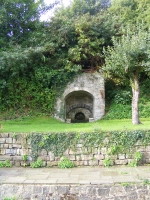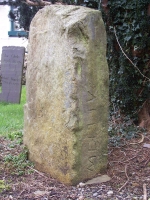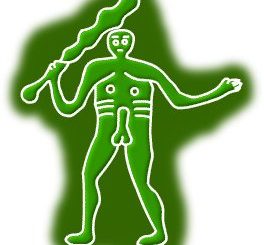Church of St Mary and St Alkelda
Dating from 1280, this is one of only two churches dedicated to St Alkeda (Alkelda,Athilda, Alcelda) (the other being in Giggleswick) and is said to be her final resting place. St Alkeda was a chaste Saxon maiden, sometimes described as a princess and a nun. On 28th March 800AD, somewhere close to the site of the church, she was strangled to death for her faith by two Danish women involved in a Viking raid. It has been suggested that they killed her by twisting a napkin around her neck. This scene was recreated in a stain glass window in the church in the 15th century, fragments of which can be seen in the North aisle west window. When the church was renovated in 1878 a stone coffin was discovered that contained the remains of a woman, who is thought to be the martyred St Alkelda. A plaque near the location reads “Near this pillar, on the spot indicated by tradition, were found, during the work of restoration, the remains of St. Alkelda, patron saint of this church, Anno Domini 1878. F. Barker, rector; T. E. Swale and S. Croft, churchwardens.”
 According to Edmund Bogg in “From Eden Vale to the plains of York or A Thousand Miles in the Valleys of the Nidd and Yore” (1894) ’Certain fee farm rents in Middleham were required to be paid upon St. Alkeda’s tomb, and these were laid on a stone table or altar in the middle of the nave, as were also some annual doles of bread.’
According to Edmund Bogg in “From Eden Vale to the plains of York or A Thousand Miles in the Valleys of the Nidd and Yore” (1894) ’Certain fee farm rents in Middleham were required to be paid upon St. Alkeda’s tomb, and these were laid on a stone table or altar in the middle of the nave, as were also some annual doles of bread.’
William Grainge who wrote in the 1800’s suggested her name could have been linked to a holy woman connected to a holy spring. Keld is the Old English name for well or spring and haeligkeld is holy well. St al-kelda could have been saint of the holy well.
St Alkelda’s feast day is 28th March which is the anniversary of her death. In 1388 King Richard II gave permission for a fair to held on the Feast of St Alkelda.
Middleham Jewel
The church displays a replica of what is known as the Middleham Jewel. This 15th century reliquary is a diamond-shaped pendant with a long oblong sapphire. It is engraved with the Trinity on the front and of the Nativity on the reverse. The jewel was found in a field close to Middleham Castle in 1985.




I’ve traced my ancestors
I’ve traced my ancestors back to 1497 and they were from this area. A branch of my distant family have remained. The eight bells were provided by the Topham family and other parishoners in 1911. In 1928 the oak pews were given by Mrs.Topham, of Middleham House, in memory of her husband Mr. Lupton Topham-Topham.. There is a fantastic oak vestry screen erected in memory of Rev. Harry Gillespie Topham M.A. Rector 1903-25 (born 17/02/1862 – died 28/02/1925). He was also a cricketer who played for Derbyshire in 1881. Inside the vestry are two medallions featuring St Alkelda. One features the martyrdom and the other her ascension into heaven. These came from a saloon yacht called the St Alkelda and built for the Topham family circa 1850. I have also come across a reference of this Harry actually seeing a ghost.
Re: Church of St Mary and St Alkelda
‘Yorkshire Legends and Traditions’ by Rev Thomas Parkinson (1888)
The Danes in Yorkshire and St. Alkelda of MIDDLEHAM.
Beneath the shade the Northmen came,
Fixed on each vale a Runic name,
Reared high their altar’s rugged stone,
And gave their gods the land they won.’
The Danes were heathen, and with them they brought their heathenish cruelties. Christians and Christian institutions were peculiarly obnoxious to them. Lingard says of them, speaking of the years immediately following 867 A.D., when they overran Yorkshire, *They could conceive no greater pleasure than to feast their eyes with the flames of villages which they had plundered, and their ears with the groans of the captives expiring under the anguish of torture. Their route was marked by the mangled carcases of the nuns, the monks, and the priests whom they had massacred. From the banks of the Ouse to the river Tyne, the towns, churches, and monasteries were laid in ashes; and so complete was their destruction that succeeding generations could with difficulty trace the vestiges of their former existence ‘(Anglo-Saxon Churches,* vol. ii., p. 220).
At this time, and thus, amongst otber pious foundations, St. Cuthbert’s monastery at Crayke, St. Cedd’s at Lastingham, and St. Hilda’s illustrious house at Whitby were wiped out, though two of them were afterwards rebuilt.
It is probably,’ says Barker, the historian of Wensleydale, ‘to this time that the martyrdom of St. Alkelda, of Middleham, must be assigned.’ Of the history, life, and death of this person very little indeed, or nothing, is really known. The churches of Middleham and Giggleswick are dedicated to her, showing her to have been in repute at the period in which they were founded.
Tradition and legend say that she was the daughter of a Saxon nobleman, and was put to death at Middleham, on account of her Christian faithfulness, by strangulation, by the Danes. In the east window of the north aisle of the church at Middleham, her sufferings are said to have been pictured in the glass ; but all that remained, a few years ago, was a small portion representing her being strangled by two females, by means of a napkin twisted round her neck.
Possibly,’ again says Barker, who is also responsible for the story which follows, * the scene of her suffering was the site of the present church, or a little to the west of it, for it is certain that her remains repose somewhere in the edifice.
A spring which rises not far off is named St. Alkelda’s well. The water of this fountain was accounted beneficial for weak eyes. Certain fee-farm rents in Middleham are required to be paid upon St. Alkelda’s tomb, and were regularly deposited on a stone table in the middle of the nave, as also were some annual doles of bread, until the stone was removed, within the memory of some persons recently living.
Re: Church of St Mary and St Alkelda
A reader e-mailed in the following:
You give the Feast Day as 28th of March which is the date given by Dr Farmer in the Oxford Dictionary of Saints; I prefer the alternative date ~ 5th of November. This date is supported by being the date of the Middleham Moor Fair for the sale of horses and cattle [originally 25th of October [=5th of November NS] under the Market Charter granted by Richard 2nd; this according to Speight’s Romantic Richmondshire.